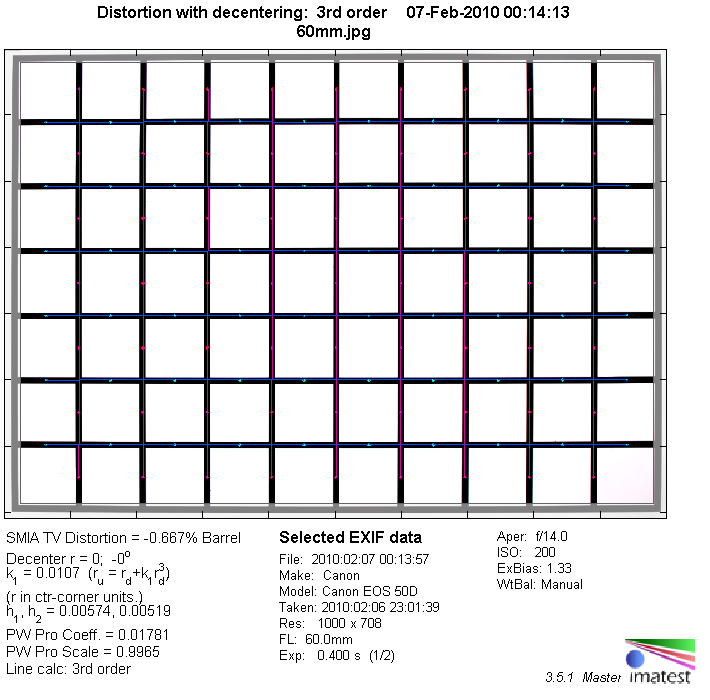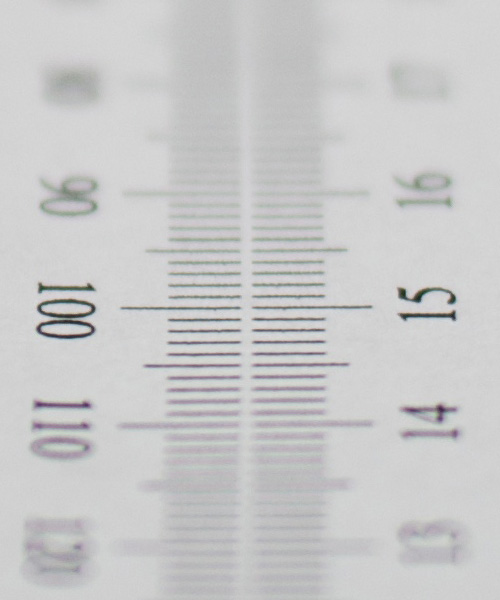|
Tamron AF 60mm f/2 SP Di II LD [IF] macro (Canon) - Review / Test Report - Analysis |
|
Lens Reviews -
Canon EOS (APS-C)
|
|
Page 2 of 3

Distortion
The lens shows a slight amount of barrel type distortion of ~0.7%. This is a little more than what one would expected from a fix focal macro lens. However, from a field perspective this can still be regarded as distortion-free (unless for really demanding work like reproduction images).
 The chart above has a real-world size of about 120x80cm.
The chart above has a real-world size of about 120x80cm.
Vignetting
Being an APS-C lens, the Tamron is expected to show some vignetting wide open. A light falloff towards the corners of 0.9EV is clearly visible in critical images but stopping down to f/2.8 helps to reduce problem. The vignetting is absolutely negligible from f/4 onwards.

MTF (resolution)
(revised) Macro lenses tend to be very sharp and the Tamron 60mm SP lives up to the rule although the capabilities of the 15mp sensor in our test are not exploited to the max. The performance at f/2 is generally on a very good level across the frame but don't expect bitingly sharp images at this setting. Stopping down to f/2.8 and f/4 boosts the center performance to excellent and the borders and corners to very good levels. Diffraction effects have a more significant impact from f/8 onwards. f/16 should be generally avoided already.
Keen readers may wonder about the rather different results of the Nikon variant at small apertures. Well, the surprise was also on our side for sure. The Nikon variant showed a significant underexposure problem leading to the speculation that an aperture of f/22 may be actually bigger here (thus less diffraction). The rather early "drop" on the Canon variant seems to indicate a smaller max. aperture than f/2 (thus smaller effective subsequent apertures) actually. We haven't seen any underexposure issues with the Canon variant but the exposure accuracy (aperture-related) is better on Canon cameras anyway.
Please note that the MTFs charts below represent the performance near infinity focus. For the time being macro performance tests are not possible.
Please note that the MTF results are not directly comparable across the different systems!
Below is a simplified summary of the formal findings. The chart shows line widths per picture height (LW/PH) which can be taken as a measure for sharpness.
If you want to know more about the MTF50 figures you may check out the corresponding Imatest Explanations

Chromatic Aberrations (CAs)
Technically the amount of lateral CAs (color shadows at harsh contrast transitions) is slightly higher than one would expect from a macro lens. However, a CA pixel width of around ~1px at the image borders is still very moderate in absolute terms and certainly no show stopper anyway. In addition lateral CAs can easily be removed via post processing.

Bokeh
Given the large aperture the lens qualifies to be used for shallow depth-of-field photography where subject separation is required and the quality of the bokeh (the out of focus areas) is of major interest here. Except for some nervousness in front of the focus field (which is not really field relevant) the Tamron shows very smooth bokeh and a pleasing softness in out of focus areas. Background highlights are very fine in the inner image zone but show a cat's eye shape at f/2 towards the image borders. The border problem dissolves from f/4 onwards.
 (The bokeh analysis was taken from our test of the Nikon variant - there's no difference here across the systems)
(The bokeh analysis was taken from our test of the Nikon variant - there's no difference here across the systems)
Bokeh Fringing / Longitudinal Chromatic Aberrations (LoCA)
LoCAs (non-coinciding focal planes of the various colors) are a common problem on fast lenses. As you may notice below the halos have different colors - magenta (red + blue) in front the focus point and green beyond. As expected the Tamron shows a moderate level of LoCAs wide open and stopping down helps to reduce the fringing considerably. Truly "apochromatic" lenses don't show LoCAs but these lenses are very rare especially below 100mm.
|
Move the mouse cursor over the f-stop marks below to observe the respective LoCAs
|
| f/2.0 |
f/2.8 |
f/4.0 |
f/5.6 |
|

|
(The LoCA analysis was taken from our test of the Nikon variant - there's no difference here across the systems)
|